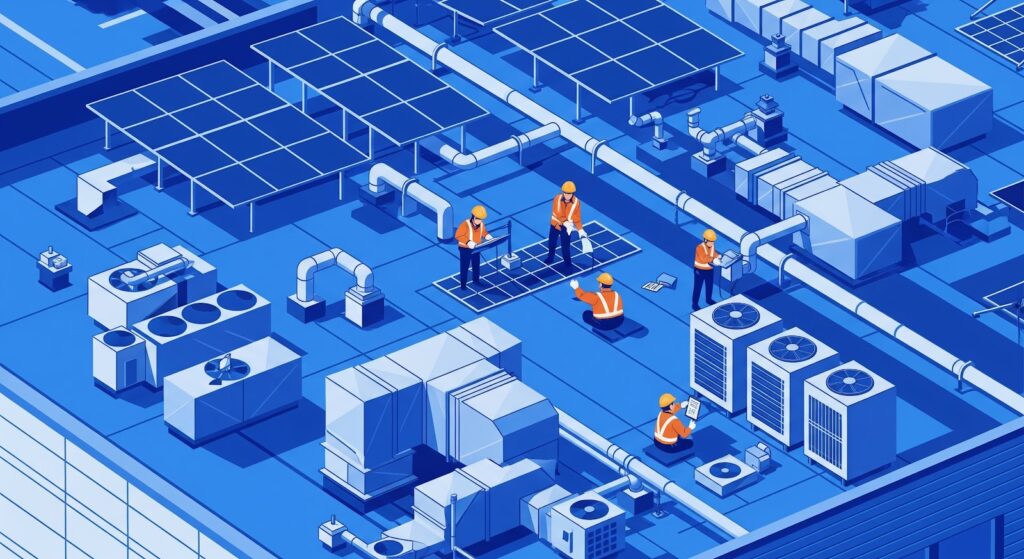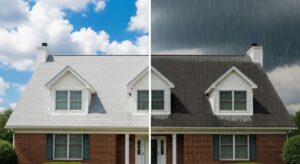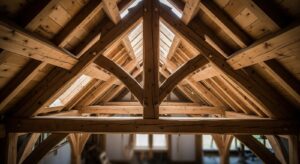A commercial roof is like the shield of your building—it protects everything inside from rain, sun, and storms. To keep it strong, following a commercial roof maintenance checklist is essential. Proactive care prevents costly damage, extends lifespan, and ensures your business stays safe and compliant year-round.
What Is Commercial Roof Preventative Maintenance?
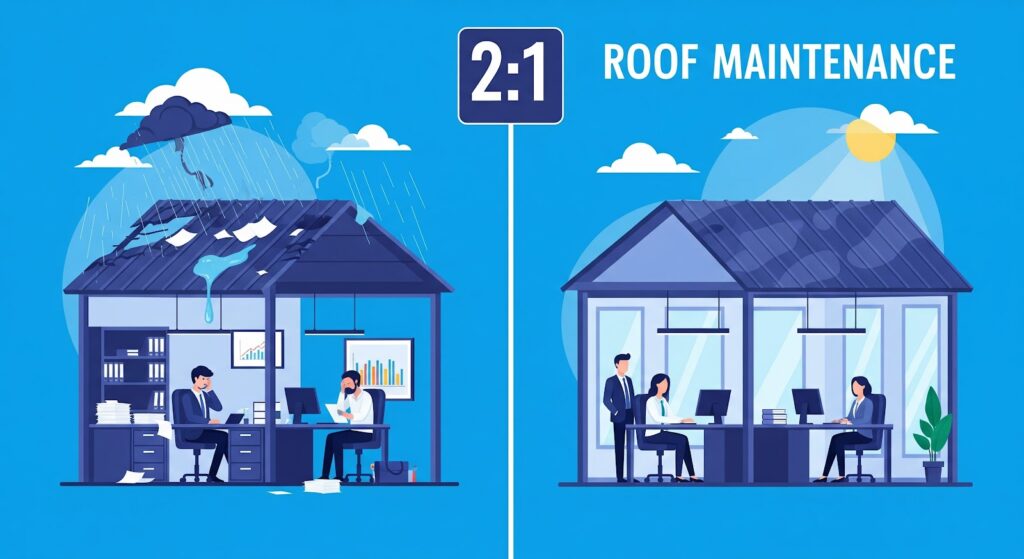
Commercial roof preventative maintenance is the practice of regularly inspecting, repairing, and caring for your roof to stop problems before they happen. Instead of waiting for leaks, cracks, or storm damage, you take action early.
The difference between preventative and reactive maintenance is simple:
- Reactive maintenance means you only fix the roof when something goes wrong—like a leak dripping onto office desks.
- Preventative maintenance is a proactive plan to find weak spots and fix them before they cause major disruption.
For businesses, this approach is critical. Imagine halting warehouse operations due to roof leaks or paying thousands for emergency repairs that could have been avoided. Preventative maintenance not only saves money but also ensures safety for employees and tenants, compliance with insurance requirements, and peace of mind knowing your property is well protected.
A commercial roof isn’t just a cover—it’s an investment. And just like vehicles need oil changes and tune-ups, roofs need scheduled checkups to stay in peak condition.
Benefits of a Commercial Roof Preventative Maintenance Checklist
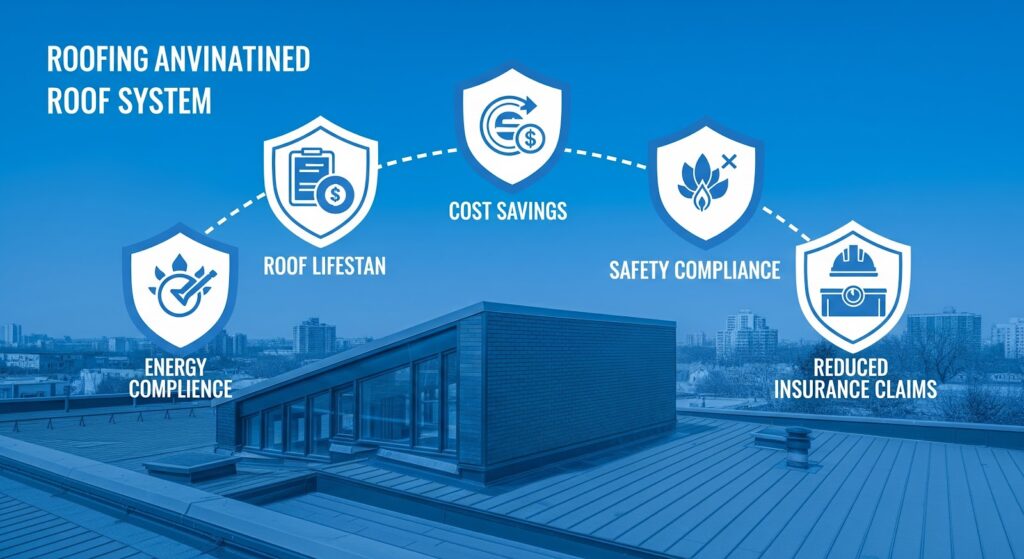
A preventative roof maintenance checklist offers numerous benefits for property owners and managers:
Extends Roof Lifespan
Regular inspections and small repairs can add years to your roof’s life. By catching early signs of wear, you delay costly replacements.
Reduces Costly Repairs
Fixing a small crack or clearing a clogged drain costs far less than repairing structural water damage. Preventative care minimizes expensive emergencies.
Enhances Energy Efficiency
Well-maintained roofs improve insulation and reduce heating/cooling costs. For flat roofs with reflective coatings, upkeep helps maximize energy savings.
Ensures Safety and Compliance
Leaks, ponding water, and loose flashing aren’t just repair issues—they can create slip hazards and code violations. Maintenance ensures compliance with building and insurance requirements.
Helps with Insurance Claims
Insurance companies often ask for proof of roof upkeep. Having a documented roof inspection and maintenance checklist strengthens claims and reduces disputes.
If you also manage residential properties, check out our guide on residential roof inspection secrets for practical insights.
Key Elements of a Commercial Roof Maintenance Checklist

A strong commercial roof preventative maintenance checklist should include these core elements:
Visual Inspection
- Exterior roof surface: Check membranes, shingles, or metal panels for cracks, punctures, or lifted sections.
- Interior signs: Look for ceiling stains, leaks, or mold inside the building.
Drainage Systems
- Inspect gutters, downspouts, scuppers, and roof drains.
- Ensure water flows freely—standing water weakens the roof and accelerates deterioration.
Roof Penetrations
- Examine HVAC units, vents, skylights, and chimneys.
- Check flashing around these penetrations for gaps or damage.
Sealants and Flashing
- Look for cracks, gaps, or deterioration.
- Apply fresh sealants where needed to prevent leaks.
Roof Edges and Expansion Joints
- Ensure secure attachments and stability.
- Expansion joints should move freely without damage.
Vegetation and Debris
- Remove branches, moss, or any foreign objects.
- Organic buildup traps moisture and causes damage.
Roof Accessories
- Inspect ladders, walkways, and safety rails.
- Ensure safety features remain strong and accessible.
A commercial flat roof maintenance checklist should pay extra attention to ponding water and drainage, while sloped roofs need thorough checks of shingles and flashing.
Seasonal Roof Maintenance Tips
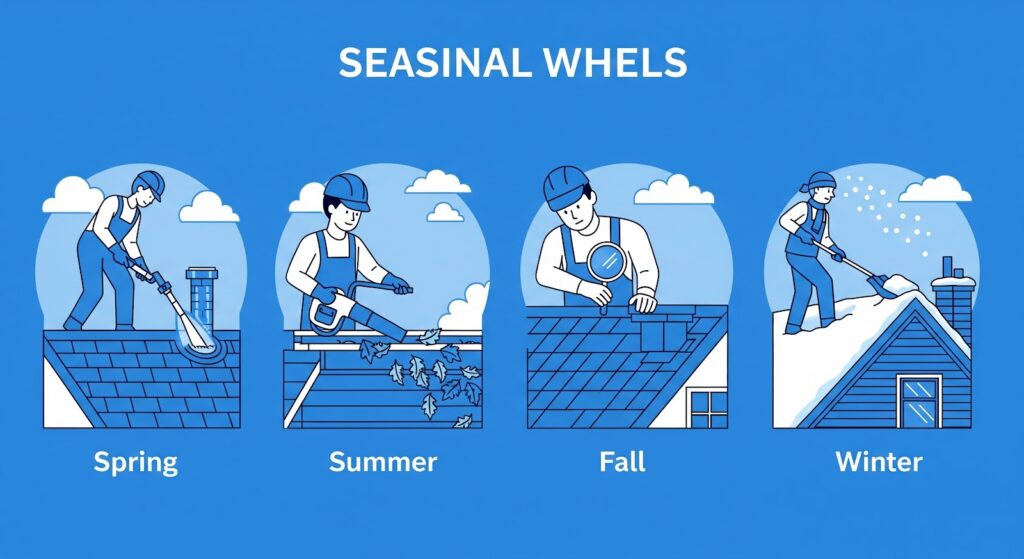
| Season | Maintenance Tasks |
| Spring | – Inspect for winter storm damage. – Clear gutters and drains clogged by ice or debris. – Look for signs of leaks caused by snow load. |
| Summer | – Watch for heat damage, such as cracks or blisters in roofing membranes. – Reapply UV coatings if necessary to protect against sun damage. – Inspect HVAC units—summer demand stresses rooftop equipment. |
| Fall | – Clear leaves, branches, and organic debris before winter. – Inspect flashing and sealants before snow arrives. – Ensure drainage systems are fully functional to prevent ice dams. |
| Winter | – Remove snow buildup safely—excess weight strains the roof. – Prevent ice dams by keeping drainage clear. – Watch for freeze-thaw damage in sealants and joints. |
By tailoring maintenance to each season, you prepare your roof for weather extremes and avoid expensive surprises.
How to Conduct a Commercial Roof Inspection

A thorough roof inspection can be done in-house or by a professional.
Who Should Inspect?
- In-house staff: Suitable for basic checks.
- Professional contractors: Recommended for detailed inspections and repairs.
Tools Needed
- Ladder, harness, and safety gear.
- Moisture meter to detect hidden leaks.
- Camera or drone for documentation.
Step-by-Step Process
- Walk the roof perimeter for visual checks.
- Inspect roof surface, penetrations, drainage, and flashing.
- Check inside ceilings for water stains.
- Test drains and downspouts with water flow if possible.
- Note even minor cracks or bubbles in membranes.
Document Findings
- Take photos of issues.
- Keep written reports or logs.
- Track repairs in a roof preventative maintenance plan.
Common Issues Found During Roof Inspections
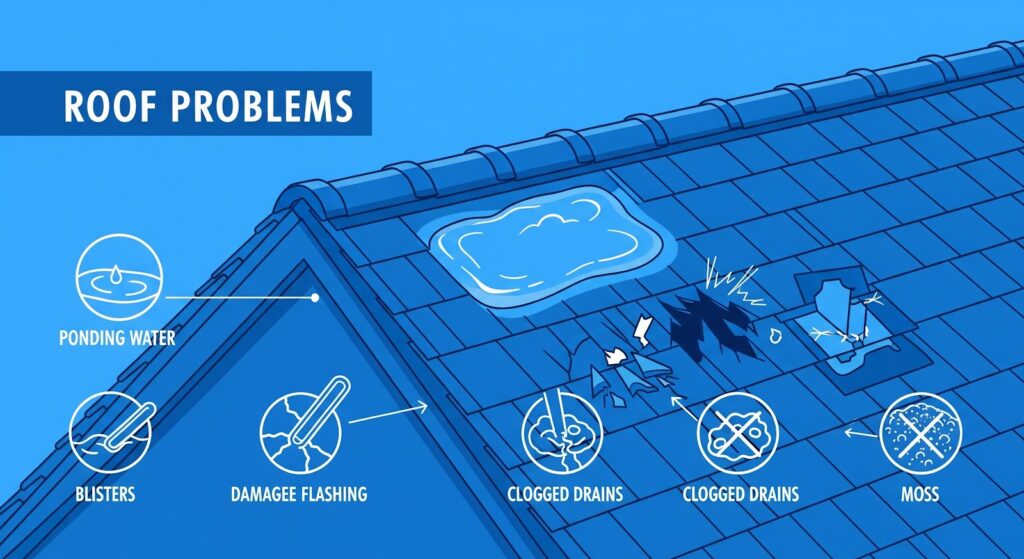
Even well-maintained roofs can develop issues. Common problems include:
- Ponding Water – Standing water from poor drainage causes membrane damage and leaks.
- Membrane Blisters or Cracks – Heat and moisture create weak spots.
- Damaged Flashing – Loose or broken flashing allows water intrusion.
- Clogged Drains – Debris buildup prevents water flow, increasing leak risk.
- Pest or Vegetation Growth – Birds, insects, or moss compromise roof integrity.
Recognizing these issues early through a commercial roof repair checklist helps prevent escalation into major repairs.
How Often Should You Inspect and Maintain a Commercial Roof?
Experts recommend inspections at least twice a year—typically spring and fall—plus after major storms.
Factors affecting frequency include:
- Roof age: Older roofs need more frequent checks.
- Material type: Flat roofs demand closer attention than sloped designs.
- Climate: Harsh weather areas require seasonal inspections.
Regular maintenance ensures small issues don’t become budget-draining disasters.
Creating a Customized Roof Maintenance Plan
Every building is unique, which means every roof preventative maintenance plan should be customized.
Steps to Build Your Plan:
- Assess Roof Type and Age – Understand specific needs of flat, metal, or shingle roofs.
- Schedule Inspections – Plan bi-annual checks and storm follow-ups.
- Assign Responsibilities – Divide duties between in-house staff and contractors.
- Maintain Records – Keep logs of inspections, photos, repairs, and receipts.
A customized plan creates consistency, saves money, and provides accountability.
Frequently Asked Questions (FAQ)
How long does a commercial roof typically last?
Most commercial roofs last 20–40 years, depending on materials and maintenance.
What’s included in a professional roof maintenance service?
Inspections, cleaning, sealing, small repairs, and a full roof inspection and maintenance checklist.
Can preventative maintenance extend a roof warranty?
Yes. Many manufacturers require proof of regular maintenance to keep warranties valid.
How much does commercial roof maintenance cost annually?
On average, $0.10–$0.30 per square foot, depending on roof size and condition.
What signs indicate immediate repairs are needed?
Leaks, visible cracks, ponding water, or stained ceilings.
Do insurance companies require proof of roof maintenance?
Often, yes. Documentation supports claims and ensures compliance.
What’s the best time of year for roof inspections?
Spring and fall are ideal, but inspections after storms are equally important.
Can preventative maintenance reduce energy bills?
Absolutely. Well-maintained reflective coatings and insulation reduce heating/cooling costs.

